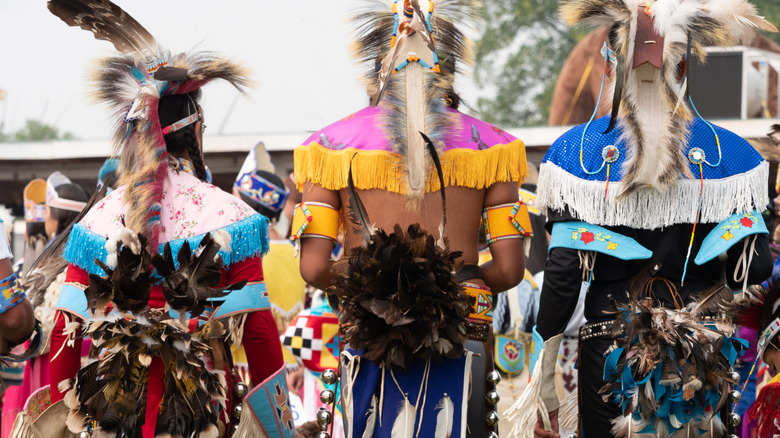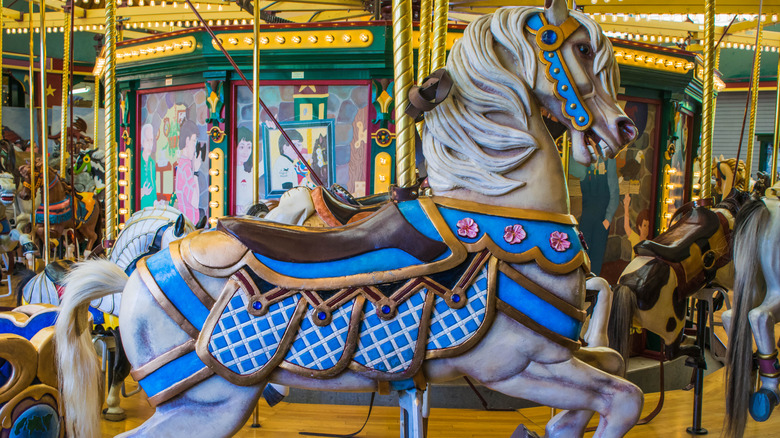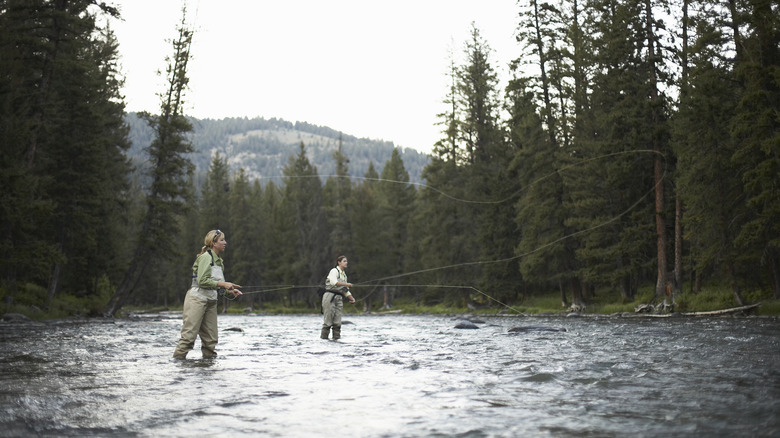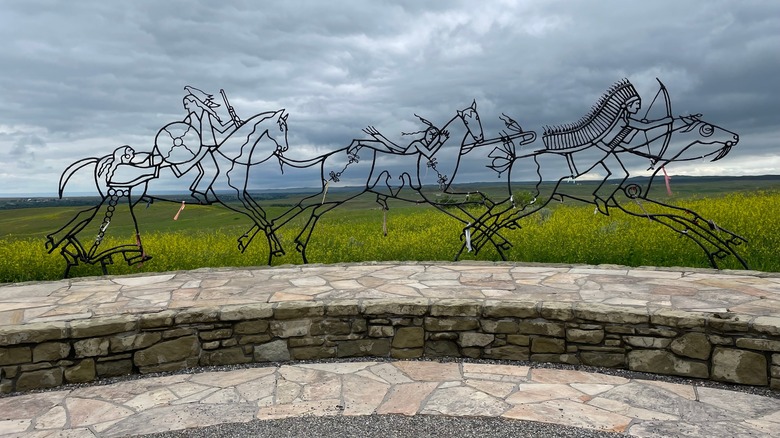The Best Things To Do In Montana Outside Of Glacier National Park
Montana is the fourth-largest state in the country, almost 150,000 square miles in size (only Alaska, California, and Texas are bigger). And yet, about 1.1 million people are spread across that land. For nature lovers, Montana feels like a dream come true, an arena of mountains, meadows, lakes, and valleys. It's also home to glaciers, most notably in Glacier National Park. One of the 63 national parks in America, it is pretty popular, with almost 3 million travelers arriving in 2023, and for good reason.
The park has some stunning scenery, from Tiffany blue alpine lakes to snow-capped peaks, from cedar forests to endless valleys. But Glacier National Park, home to one of America's most scenic roads, is not the sole star of Montana. Using blogs, tourism sites, and reviews, we've tracked down the best things to do in Montana outside of Glacier National Park.
Tour Yellowstone National Park
While the vast majority of this iconic park is in Wyoming, 3 percent of it is in Montana. The North Entrance is actually in Montana and is the only entrance open all year round. Yellowstone is truly a natural wonder, the first national park, created in 1872 and spread over more than 2 million acres of rugged terrain. It's a realm of fascinating, and perhaps surprising, thermal and geological wonder, where the rare recurs.
Visitors can find the iconic spouting geyser Old Faithful, which shoots plumes of water into the atmosphere with almost clockwork regularity. Or the hypnotically colored Grand Prismatic Spring, the largest hot spring in Yellowstone. Yes, indeed, the park's top highlights are actually in Wyoming, but if you are in Montana, you have a way in. And if you're on a budget, you can employ some clever tricks when visiting in the summer on a tight budget.
Go museum-hopping in Bozeman
Bozeman might dazzle visitors with its outdoor pursuits — from ski resorts in the nearby mountains to hiking trails all around — but it's the museums that might be the city's real star. An obvious starting point would be the Museum of the Rockies, part of Montana State University. While its topics cover many different facets of life in the West, including early farming and Native American history in the region, it's the dinosaurs that stand out.
This is where you'll find one of the most extensive, and impressive, collections of dinosaurs on the planet, including one of the biggest skulls ever discovered. Information, and its dissemination, come under the microscope at the American Computer & Robotics Museum, where tablets from the era of Babylon date back thousands of years. Travelers can enjoy local and international pieces at the Bozeman Art Museum, displays on pioneer life in the region at the Gallatin History Museum, and wander the numerous galleries around town.
Visit a reservation
Native American culture runs deep through Montana, and there are reservations in the state that travelers can visit. Next to Glacier National Park, the Blackfeet Reservation unfurls across 1.5 million acres of mountain foothills and undulating plains. Closer to the border of Washington state, Flathead Reservation is a slightly smaller reservation and is home to the Kootenai and Salish people. As a simple start, visitors can come to the reservations for recreational purposes, to fish, hike, and even overnight in the campgrounds.
Travelers who want to know more about Native American cultures also have the option of visiting specific sites. In Browning, the Blackfeet Heritage Center & Art Museum showcases works by hundreds of artists that represent tribes from around the U.S. Within the Flathead Reservation, the Three Chiefs Culture Center features educational, cultural, and folkloric strands, and also displays traditional crafts. Visitors looking for a grand spectacle should consider timing a trip to the Crow Fair. Held in August each year, it is the biggest event celebrating Native American culture in the state. Anticipate cultural activities and performances, traditional crafts, parades, displays of accomplished horsemanship, and a deep celebration of the rich history of the Apsáalooke people.
Tube down the Clark Fork River
One of the major waterways in Montana, the Clark Fork River not only supports a thriving fish population, but it's also essential for animals and birds that live around its banks. It also is a great place to spend some quiet time, especially on a tube. When booking a trip with Clark Fork Yacht Club, visitors will be put into the river at Sha-Ron Beach in East Missoula and enjoy a leisurely float for a few tranquil hours down the river. Mornings tend to be a quieter time on the river, good for families with children.
By the afternoon, the atmosphere livens up, and the river becomes a staging ground for some aquatic festivities (the tubes have drink holders). That said, there is an age limit for participants, so kids under 14 aren't allowed to take part. For travelers who are able to join, the experience is one that is refreshingly low-tech, low-key, and low-impact — basically a welcome break from daily life.
Snap photos with alpacas
An interesting fact that not everyone might know, is that the alpaca is actually related to the camel. They are substantially smaller than camels, though share the physiological features of long, slim necks and legs. What makes alpacas different from their distant relative is the hair that grows around much of their body, so they appear bushy and fluffy. Alpacas also have no top teeth in the front of the mouth, further enhancing their cuteness.
In Bozeman, you can quickly you'll fall in love with those creatures during a farm tour with Alpacas of Montana. Tours are about 90 minutes in length and are available throughout the year. You can get close to the alpacas, and even take photos embracing them. If you're really lucky, you might be around when baby alpacas are born (often in the spring), and you might be able to hold one. That definitely calls for an "awwwwww."
Ride an old carousel
In an era where roller coasters, like the world's first ocean roller coaster, get ever more fast and fearsome, there's something a little comforting about more sedate amusement park rides. A Carousel for Missoula lets riders enjoy a window into the past by allowing visitors to mount the hand-crafted carousel horses and take them for a few rounds. Beyond the simple pleasure of offering a throwback thrill, the carousel has a fascinating backstory.
A woodworker in Missoula, inspired by his childhood memories of riding a carousel, vowed to build one from an old carousel he had bought in pieces. This was in 1991, and by the middle of 1995, with the help of 100,000 hours of work from volunteers, the carousel opened. It required the restoration of more than 15,000 pieces of the structure, the motor that drives it, and the various accents. Today, it has ponies, chariots, gargoyles, stained-glass panels, and a huge organ that are all a testimony to the power of community.
Enjoy some public art
In downtown Billings, a public art program has brought color, whimsy, and artistic delight to the core of the city. North of Montana Avenue, and east of Division Street, a number of public artworks have become beloved local sights. They include the painted traffic-light boxes, where bright slashes enliven what is a humdrum, yet essential, part of the urban fabric. There are also plenty of murals around this part of town, including a giant bison's face on the side of Jake's Downtown, a steakhouse that is a fixture in Billings.
This rich vein of public art isn't, however, reserved only for Billings. In Bozeman, visitors will also encounter a grand assortment of painted traffic boxes, a way to inject the cityscape with public art, and also help to reduce the incidence of graffiti. Look forward to boxes painted with cowboys, flowers, landscapes, Native American portraits, and much more.
Take a scenic drive
For a state so blessed with vast tracts of unspoiled nature, choosing the best scenic drive out there is hard to do. There's the amazing Going-to-the-Sun Road in Glacier National Park, but outside that park, one showstopper is the Beartooth Highway. It's a drive for the ages, also known as the Highway to the Sky. Technically a section of U.S. Route 212, it links the town of Red Lodge to Yellowstone National Park, twisting and turning for almost 70 miles. Its highest point is Beartooth Pass, 10,947 feet above sea level, but that is just one of the highlights. Drivers will see grand panoramas of high forests, rolling plains of tundra, and alpine lakes.
There are mountain ridges and peaks in all directions, and frequent switchbacks mean that even though the drive isn't long, it requires great vigilance to complete. Only open seasonally, usually from spring until the middle of fall, the drive is not to be missed. Just see what this contributor on Tripadvisor has to say about it. "This is one of the most beautiful drives I've ever been on. You are so high up. The sky was so blue and the views were so great. It's truly amazing."
Try fly fishing
Starring Brad Pitt, and directed by Robert Redford, the movie "A River Runs Through It" was set in 1920s Montana. A drama that explores the relationship between brothers and their strict father, it also heavily features fly fishing and examines the role it plays in the brothers' lives. Fly fishing continues to be a popular pastime across the state, and for anglers who enjoy this meditative practice, Montana is akin to the Holy Grail of places in the U.S. to dabble in it.
There are waterways throughout the state where fly fishermen will find ideal conditions for casting their lure. The Bitterroot River, Yellowstone River, and Missouri River are all rich realms for some aquatic adventures. Any visitors wanting to emulate the passages of "A River Runs Through It" should head to the Blackfoot River — the novel, by Normal Maclean, is set there. Fishermen will find lots of trout, as well as scenery to make their hearts hum with joy (large rocks in the river, the occasional frothing rapids in the emerald shallows).
Visit a memorial to Native Americans
June 1876 was a seminal time for Native Americans, as this was when the battle of Little Bighorn took place. At the time, Arapaho, Cheyenne, and Lakota men fought against General Custer and his troops in a war that looked to restrict Native American customs and cultures. You can visit Little Bighorn Battlefield National Monument to honor those fallen warriors, and learn more about this landmark era in U.S. history. Photos exhibitions show images of soldiers from both sides, and there are also displays of traditional Native American crafts and ornaments.
You can pore over letters written by U.S. Army troops and also their families, moving passages describing the effects of war on combatants and their loved ones. There are also maps, drawn by hand, that detail the movements made by Custer's troops, plans that immediately take the onlooker back almost 150 years. An Indian Memorial, unveiled in 2013, marks the sacrifices made by Native Americans all those decades ago.
Go rafting on the Gallatin River
Tubing anywhere is a great way to peacefully unwind on the water — just check out these Midwest rivers that are the perfect places for a thrilling day of tubing — and Montana is no exception. But visitors who want a little more oomph in their river adventures should consider whitewater rafting. Challenging waters are found all over the state, and among them is the Gallatin River. Montana Whitewater takes adrenaline junkies out on the river for some thrills, and hopefully no spills (though for some paddlers, capsizing is part of the fun).
Depending on a traveler's level of expertise in paddling and rafting, the operator can choose from different sections of the river. Big Sky is often the starting point of an excursion, and rides can be relatively calm, or they can include the churning, wild Class IV Mad Mile rapids. Visitors looking for the most raging torrents should plan their trip for the spring when the flow is at its peak.
Explore sandstone outcroppings
Billings clearly has plenty in the heart of town to keep visitors engaged. But on the outskirts of the city, a natural phenomenon presents travelers with another reason to love the city. The Rimrocks are sandstone formations that formed millions of years ago by an ancient sea. Sand appeared by the shore of that sea, but when the water receded, that sand eventually became rock or sandstone. Today, The Rims, as the locals call these rocks, is an excellent place to hike, bike, or climb.
Spaces like Swords Park sit on The Rims and allow Billings residents an easy escape from the heart of the city, and a place to stay active. They also come with fine views, especially at the Four Dances Recreation Area. Populated with sagebrush, pine, and cottonwood trees, this slice of nature has some steep cliffs with lovely, elevated vistas of Billings and the Yellowstone River.
See some waterfalls
If you love waterfalls, you might want to spend some time in Glacier National Park — it has hundreds of them. But don't think that this is the only place in the state that has them, as there are many more elsewhere. Ousel Falls is an easy walk from Big Sky and is a scenic tiered falls with lots of forests all around. Kootenai Falls is one of the most impressive cascades in this part of the country, with the water sloshing around a set of rapids before the sudden drop of 30 feet over the falls.
There is a swinging bridge, always good for a little bit of adventure, that reaches across the river and offers impressive views of the falls. One of the most picturesque cascades is the Fall Creek Falls. This trio of drops unravels over a one-mile section of river, and each waterfall is about 30 feet high. To see all three, you'll need to be a good hiker accomplished enough to deal with thick bushes, faint trails, and crossings across burbling creeks.
Hang out with a grizzly
Brown in color, grizzly bears can grow to fearsome proportions — some get as large as 700 pounds and they have long claws that are invaluable for digging. These are some of the facts that you might learn at Montana Grizzly Encounter, a sanctuary and education center for grizzlies. Located in Bozeman since 2004, it houses orphaned grizzlies or ones that have been rescued from captivity. The animals are free to wander, without being confined to cages, or ogled at by visitors driving by in cars.
There is information all over the facility about these bears, and school groups are frequently spotted coming to the sanctuary. Visitors will find viewing areas where they can watch the bears at play, while staff are on hand to answer any questions. Guests that want to learn even more about the bears can attend talks by the bear keepers, held throughout the day.
Go hiking
The hiking possibilities around the state are mind-boggling, which isn't surprising since so much of the state is undeveloped. Glacier National Park might get plenty of plaudits for its endless hiking options, but right next door, Flathead National Forest is not to be overlooked. It has 2,000 miles of trails in its 2.4 million acres of land. Visit, and you'll be able to see rivers, lakes, and endless legions of trees sometimes shrouded in mist. Travelers can make an extended trip out of a visit to the forest by overnighting in the campgrounds there or hitting some of its ski slopes. Wilderness fans might get a kick out of seeing grizzly and black bears during a journey there.
But you don't have to go into the distant wilds of Montana to get in some great hiking. Close to Bozeman, the M Trail is a rewarding day hike. It gets its name from the giant "M" etched into the landscape at Bridger Canyon, the work of Montana State University students more than a century ago. To get to the M, walkers can take one of two routes, both of which will test your calf muscles. At the top, you can see the Gallatin Valley unfurl below.
Ski at Big Sky Resort
As names for ski areas go, Big Sky Resort is pretty special. It hints at the epic landscapes here, large peaks that soar up toward grand, open skies. Snow bunnies will adore the slopes at this mountain resort, a place that offers traditional downhill runs. But that's not all. There is also cross-country skiing, night skiing using a headlamp, snow bikes, snowshoeing, dog sledding, and a full ski village with restaurants, shops, and plenty of lodging options. Don't ski, or hate the cold? That's not a problem.
Big Sky Resort also has a full roster of activities available in the warmer months. You can take a lift ride for the thrill of it, and also for the fine views it affords. Adventurers might be drawn to mountain biking, hiking, or even horseback riding, while for more thrills, consider soaring through the sky on a zipline. For even more elevated fun, hit the rock faces for some climbing.
Methodology
Glacier National Park might be one of the shining jewels of Montana, but the state is rife with other destinations worth visiting. To find the best things to do outside of the park, we looked at parks department sites, state tourism blogs, and USDA Forest Service pages. We also found blogs like Roadtrippers and Grizzle Hackle Fly Shop that detailed some of the great things to do in the state, from outdoor pursuits to art-filled wanders.

















